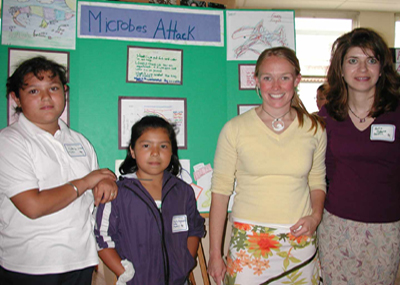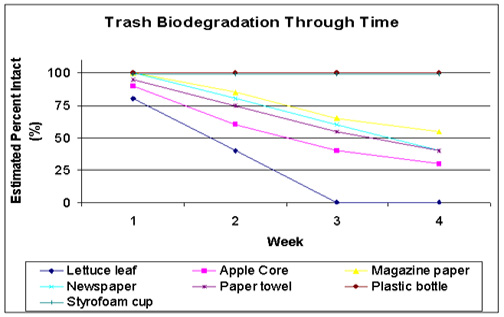|
Mrs. Osborn’s Class Experiment Page Microbes Attack

Students share their research at the poster session
Purpose: To find out what type of trash biodegrades the fastest over time.
Hypothesis: Some types of trash biodegrade fast, and some slow. Over four weeks the apple core, lettuce leaf, magazine paper, newspaper, and paper towel will biodegrade fastest and the plastic bottle and styrofoam cup will biodegrade slowest.
Materials: 2 apple cores, 2 lettuce leaves, 2 pieces of magazine paper, 2 pieces of newspaper, 2 paper towels, 2 plastic bottles, 2 styrofoam cups, 14 re-sealable plastic bags, measuring cup, potting soil, water, 14 straws, permanent marker
Methods:
- Put two cups of potting soil in a re-sealable plastic bag.
- Add enough water to completely moisten the soil.
- In each bag, place one trash item.
- Label the bag with the date and trash item inside.
- Insert a straw into each bag, but not into the soil to allow for air circulation inside and outside the bag. Seal the bag around the straw.
- Keep the experiment in a warm place.
- One week following experimental setup, open each bag and remove trash item. Record observations about the trash: size, smell, texture, temperature (i.e. warm, room temperature, or cold), and appearance.
- Bury trash item back in the soil, insert straw, and seal the bag. Keep in a warm place.
- Check the experiment weekly, recording observations about the trash each time.
Results:

Conclusions: Our hypothesis was correct; the lettuce leaf, apple core, paper towel, magazine paper, and newspaper all biodegraded the fastest. From our results we noticed that there seems to be three categories of biodegradation: slow (plastic bottle and styrofoam cup), medium (paper towel, newspaper, and magazine paper), and fast (lettuce leaf). In the future, students might want to predict the time of biodegradation for three categories.
|

